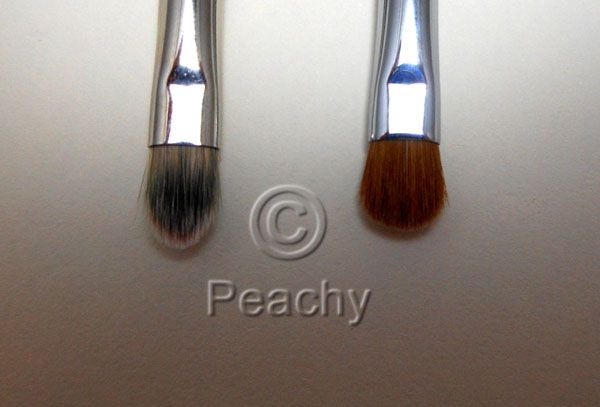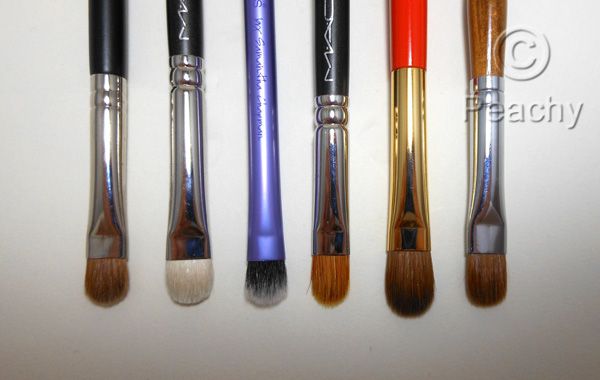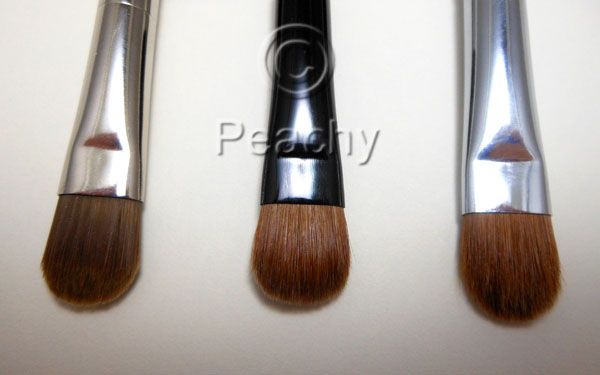Small Shader Brushes
These brushes are both about 1/2 inch wide and are the smallest shader brushes in my collection. The one on the left is a Sephora synthetic and the one on the right is a sable brush from a beauty store. In this case, sable probably means blunt-cut, like a second from a higher quality brush.
This size is obviously good for smaller lid areas, so if you have small eyes, you might want to consider this size. It's also good for detail work, applying eyeshadow to the inner third, highlighting the center, or darkening the outer third, as its small size ensures dense placement. It applies a strong highlight to the brow bone and shadow under the eye to define. This size also makes a terrific lip brush, especially for fuller lips. I actually bought the Sephora one for that purpose.
Medium Shader Brushs
The medium shader brush is the most basic of all eyeshadow brushes. This is the most versatile of all the sizes, and is what most people will be looking for. This set is about 3/8ths of an inch wide, and vary in length between 3/8ths of an inch and 5/8ths of an inch.
These are great for applying eye shadow to the lid, especially if you want to pack on color, for either a strong look or when using a sheerer shadow. They can be turned on their side and the tip used to apply shadow in the crease or under the eye. From left to right they are an unknown hair by Japonesque, a goat hair by MAC, Real Techniques shading brush which is synthetic, a mix of natural and synthetic by MAC, a beautiful weasel by Hakuhodo, and another sable by Brandon that I got at a beauty store more than a decade ago and was my first "real" brush. The natural/synthetic mix is good for laying down either powders or cream, and the goat is especially good for dense applications, the weasel is amazing and applies eyeshadow super smoothly. These are also likely going to be the brush to turn to for applying powder shadows wet for foiling or super-dense application. They can also double as concealer brushes for applying under the eyes or on large areas for redness.
Large Shader Brushes
These large brushes are about 1/2 inch wide, and are synthetic MAC, mix of synthetic and natural by Paula Dorf, and sable by Brandon.
These are good for applying a base, either cream or powder. Even though they are very wide, they are still flat, so they apply more product to the lid than a fluffier brush would. This makes them great for something like a MAC paint pot, when you want to apply a thin but very even layer. They also work well, obviously, for someone with a large or flat eye area.
Pros and Cons
Pros: The flat shader brush is easy to use and versatile. It's good for basic looks or as a base or detail brush for more complicated makeup. They work well for wet or dry application and, depending on the hair type, are appropriate for cream shadows. They can double as concealer brushes and lip brushes. They are useful for applying shadow to nearly every part of the eye area. A shader brush is likely available in every line and price range, is often the core of the line, such as the Shu Uemura Natural 10, or the MAC 242, 239 etc.
Cons: These are not blending brushes. While they can soften the demarcation between two colors applied to the mobile lid, these won't work well to blend a gradiant, so you'll need to use another brush to blend (fortunately, blending brushes will be the next brush types featured). While they make for surprisingly good crease brushes when the tip is used, most eye shapes will prefer to use a separate crease or blending brush there.
I fully believe a flat shader brush should be everyone's first eyeshadow brush. These three sizes were my first three brushes, and I still remember the pride that my eyeshadow finally looked the way I wanted it to. Choose one that fits your eye size, your budget, and how you want to use, and you will likely find yourself using it every day, whether your eye makeup is subtle or exciting.
The brushes featured in this post are: Sephora Synthetic Eyeshadow 18 (dc'd), Brandon Mini Shading Brush, Japonesque Eye Detailer Medium, MAC 239, Real Techniques Shading Brush, MAC 242, Hakuhodo S132, Brandon Fluff Brush, MAC 249, Brandon Shading Brush, Paula Dorf Wet/Dry Eye Color. All were purchased by me and I was not compensated for this post. One caveat: the Brandon brushes I own were bought more than a decade ago, while they still have brushes by the same name available, I make no promises that they are the same brushes featured here.







No comments:
Post a Comment